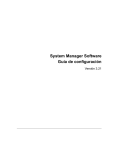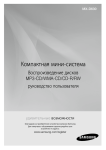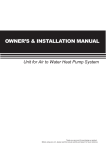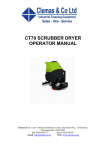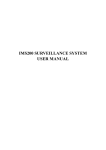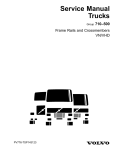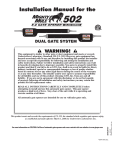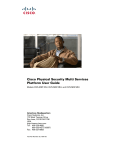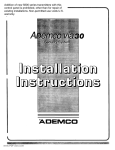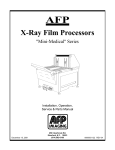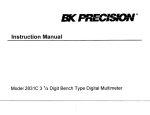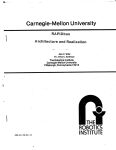Download Field balancing in the real world
Transcript
OAK RIDGE NATIONAL LABORATORY
ORNL/CP-94697
FIELD BALANCIN G I N
THE R E A L W O R L D
PREPARED FOR
CSI RELIABILITYWEEK
OCTOBER
13 -16,1997
OPRYLAND
HOTEL,NASHVILLE,
TN
BY
BOB BRACHER
. ..
.
.
,
.
.
.
.
-
.,
. .
.. ...
-
.._._._i_,,".
._l_.
..-
-,.-
DISCLAIMER
This report was prepared as an account of work sponsored by an agency of the United
States Government. Neither the United States Government nor any agency thereof, nor
any of their employees, make any warranty,express or implied, or assumes any legal liability or resporrsibiiity for the accuracy, completeness, or usefiulness of any information, apparatus,product, or process disclosed, or represents that its use would not infringe privately
owned rights. Reference herein to any specific commercial product, process, or service by
trade name, trademark, manufacturer, or otherwise does not necessarily constitute or
imply its endorsement, recommendation, or favoring by the United States Government or
any agency thereof. The views and opinions of authors expressed herein do not necessarily state or reflect those of the United States Government or any agency thereof.
Plant h Equipment Division, O W L
Abstract: Field Balancing in the Real World
Field balancing can achieve significant results when other problems are present in the
fiequency spectrum and multiple vibrations are evident in the waveform.
Many references suggest eliminating other problems before attempting to balance. That’s
great-if you can do it. There are valid reasons for this approach, and it would be much
easier to balance machinery when other problems have been corrected. It is the
theoretical ideal in field balancing. However, in the real world of machinery maintained
for years by reacting to immediate problems, the classic vibration signature for unbalance
is rarely seen.
We make most of our decisions with limited information. The decision to balance or not
to balance is usually made the same way. This paper will demonstrate significant results
of field balancing in the presence of multiple problems. By examining the data available
and analyzing the probabilities, a reasonable chance for success can be assured.
Bob Bracher, Vibration and Training Specialist
Oak Ridge National Laboratory
managed by
Lockheed Martin Energy Research Corporation
Post OMice Box 2008
Oak Ridge, Tennessee 37831-6411
September 5,1997
Notice: The submitted manuscript has been authored by a contractor of the U. S Governmentunder Contract
NumberDEAC05-960R22464. Accordingly, the U. S Governmentretains a non-exclusive, royalty-freelicense
to publish or reproduce the publishedform of this contribution, or allow others to do so, for U. S Government
purposes.
Oak Ridge National Laboratory is managed by Lockheed Martin Energy Research Corporation for the U. S.
DeDartment of Enem.
Technical Training Department
Field Balancing in the Real World
Acknowledgements
In a large, multihnctional company such as ORNL, it takes the efforts and contributions
of several groups and individuals to bring about the change necessary to implement new
techniques and ideas. Field balancing is not new. The idea of doing it on our own is new.
Without the efforts of Eddie Baird, Wayne Castleberry, Doug Edwards, Bob
Hileman, Blake Van Hoy, and J. J. Vivyan we would not have been able to perform the
jobs mentioned in the case histories. Their efforts were made possible by the cooperation
and support of managers, administrators, field maintenance and operations staff, and
consultants of ORNL Plant & Equipment Division, OlWL Waste Management Remedial
Action Division, and ORNL Environmental Restoration Division. Their continued efforts
and support is appreciated.
CSI deserves some credit, too, for the many times they helped me resolve problems by
telephone, in class, or in person. I particularly want to express my appreciation to the
training, information desk, sales, software, hardware, and technical support groups, and
specially to Darla Adcock,
Introduction
This paper will discuss case histories of field balancing jobs successklly accomplished at
Oak Ridge National Laboratory (ORNL) in the presence of other vibration problems. A
demonstration will explain by example the cases presented here. ORNL Journeyman
Millwright Doug Edwards has agreed to assist me with this demonstration. I am gratefbl
to him for his enthusiasm, skill, and dedication to predictive and proactive maintenance
technologies. I enjoy working with him and I think you will too.
P List of CSI Equipment Used
Overview
>
>
>
>
>
>
>
>
Field Balancing Basics: Decision to Field Balance
Field Balancing Guidelines
Case History One: The Underbalanced Overfire Blower
Case History Two: The Confident Consultant
Case History Three: The Doubtfbl Backup
Demonstration of Multiple Problems
Summary
Recommendations
P References
& Appendices A & B
>
>
>
>
>
List of CSIB Equipment Used
CSI 21 15 Machinery Analyzer (a single-channel analyzer)
CSI 404 Infrared Phototach
CSI 440 Strobe Package
CSI FAST Bal I1 Downloadable Program
CSI Cascade Downloadable Program
Bob Bracher, Vibration and Training
2
Plant & Equipment Division, ORNL
Field Balancing Basics: Decision to Field Balance
Appearance of Unbalance Signature
The lx magnitude is always increased with an unbalanced condition in rotating
machinery, and it is usually highest in the radial direction. A single peak of excessive
vibration at l x running speed (or 1 order) is the classic unbalance signature. An
accompanying waveform with a nearly perfect sine wave all but confirms it, right? If all
of these things are true, the decision to field balance ought to be fairly easy to make from
one set of data.
0ther Factors
The problem arises when the forcing fimctions causing excessive l x peaks are examined.
Some, such as (1) bent shaft, (2) eccentricity, and (3) unbalance (center of gravity and
center of rotation do not coincide), will respond to field balancing. Others, such as
(4) severe looseness, (5) resonance near running speed, and (6) cracked shaft, will not
respond successfully to field balancing. To complicate matters, misalignment can be
mistaken for unbalance, and unbalance can be mistaken for misalignment. Misalignment
can exhibit a lx peak only. An overhung rotor can exhibit a high l x in the axial direction
or the radial direction, as well as a high 2x running speed peak.
Additional Tests to Confirm Unbalance
There are several ways to confirm that a field balance correction would decrease the
vibration in rotating machinery: (1) On a single-plane rotor, phase data between the two
bearings can help to confirm an unbalance condition. If the vibration of the two bearings
is in phase, it is likely unbalance rather than misalignment. If the vibration is 180 degrees
out of phase, the problem is likely misalignment. (2) Bump tests can rule out resonance
within 10-20% of running speed (difficult or impossible to balance successfully).
(3) Waterfall or cascade plots of coastdown and runup data can also help. All of the tests
mentioned can be performed with a single channel analyzer, such as CSI’s 21 15, and a
tach trigger.
A Note on the CSI Cascade Downloadable Program
When properly set up and operated, this program and the cascade plots produced can
provide a wealth of reliable information quickly. CSI’s Cascade Downloadable Program
can reveal a resonant frequency too close to running speed, some transient events, and
magnitude in relation to varying running speeds.
Balancing Standards
The decision to balance must take into consideration some standard that can be met.
Currently, the primary standard used on commercial fans and pumps at ORNL is
customer satisfaction. Objective standards for assessing field balancing results can be
stated in maximum ounce or pound inches of residual unbalance remaining, or they can
be stated in terms of a vibration magnitude limit at a certain location at lx turning speed.
Balancing standards will vary greatly with application, consequences of a machine
failure, and customer requirements. The balancing of rigid rotors is covered in ANSI
Standard S2.19-1989.
3
Technical Training Department
Field Balancing in the Real World
Field Balancing Guidelines
L
Preliminary Checks:
Complete Safety Work Permit according to YOUR COMPANY’S procedure.
Lockouthagout equipment according to YOUR COMPANY’S procedure.
Inspect machine to be balanced even ifit has already been inspected for any of the
following problems that could preclude a satisfactory balance of the machine:
A.
Cracks in foundation, grouting, welds, mounting hardware, rotor, etc.
B. 0 Loose mounting bolts, debris, hardware, bearings, or couplings.
C. 0 Missing parts: keys, set screws, balance weights, etc.
D. 0 Damaged or broken parts: coupling, belts, bearings, etc.
E. 0 Deformed parts: bent blade, misshapen belts, etc
F.
Discoloration of moving parts
G. 0 Excessive wear of visible moving parts.
H. 0 Too much, too little, or burnt lubrication.
I.
Dirt or debris on rotor
If any of the above items were checked and not corrected, report findings.
4. c]
Clean the rotor of the machine to be balanced if it is dirty.
5. 0
1.
2.
3.
n.
17
Typical Machinery Vibration Analyzer Equipment Setup:
Mount two vibration transducers radially at each bearing.
Install reflector tape for PhotoTach reference on shaft connected to rotor.
Mount PhotoTach to read reflector tape on center and perpendicular to rotor shaft axis.
Connect Phototach, multiplexer, and cabling to machinery analyzer and accelerometers.
Set up the job in the machinery analyzer.
Ensure that cords, accelerometers, and equipment will not interfere with shaft rotation.
CAUTION: From this point on, permits and lockouthgouts may need to be suspended temporarily
and then reinstated until the field balancing job is complete. Follow YOUR COMPANY’S procedures
applicable to this job. Actual step-by-step of balance job will vary.
IIL
Typical Steps for Single-Plane Balancing
1. Acquire reference data.
2. Add one or more trial weights.
3. Acquire trial run data with trial weights in place.
4. Remove trial weights.
5 . Determine whether to add or remove weight to balance.
A. Calculate correction weight and location required to balance machine (add or remove).
B. If adding weight, permanently aflix correction weight; if removing, calculate area needed for
removal and remove weight.
6. Check results and trim balance as necessary.
7. Repeat trim runs as necessary until within tolerance or acceptable to customer.
8. If trim balance calls for too much weight (>50% of correction), reevaluate job.
9. Return machine to customer according to YOUR COMPANY’S procedure.
Bob Bracher, Vibration and Training
4
Plant h Equipment Division, ORNL
Case History One: The Underbalanced Overfire Blower
Nature of Involvement
No vibration readings had been taken on this fan before September 27, 1996. The resident
millwright-Eddie Baird-had known of our program and some of our equipment, and
he recommended our services to the relief supervisor.
Known Facts
New bearings had been installed in the motor, and the fan rotor was cleaned. The fan
shook the entire second floor of the steam plant when the operators tried to run it. This
fan had motor bearings only.
A set of vibration data was taken to verify that the fan was out of balance. The vibration
was directional to some extent, with the horizontal reading >4x the vertical reading.
Relevant Spectrum
Spectrum After Balance
2619-Ovemre Blower, Boller #2
1619-OBW2MOH Motor Oulboard Horizontal
2.0
72
I
'
5
27SEP86
1.661 ips
,
12
$
f
Rw(rSprdrum
,
,
,
,
,
-
m:59
OVRALL- ld6VDG
PK 1.66
LOAD = 100.0
RPH- S72.
ws s o u
oa
0.6
04
02
0
0
1s
I
O W L - .324OVDG
3.0
Fnqumcy h O r d i
Mal: Bbfororr Baiurslng, N w Bearings
Fig. 1. Initial spectrum.
Fig. 2. Final spectrum.
PK = . r X S
LOP9 .
Irm.0
RPH. 5572.
RPs- 6963
Decision to Balance
The decision to balance was made on the basis of work already performed, major lx
vibration, and the comparatively low magnitude of the 2x-4x harmonics. During the
balance job, the software help message (CSI FAST Bal I P ) advised that the vibration
was directional at one measurement location out of four. We continued to balance, and
the spectrum above shows the pleasing result. Incidentally, the weight had to be placed at
the same phase location as the original weight, hence the name for this case history.
Other Fan Problems
After field balancing, the 2x-4x fan harmonics are now -20% of overall vibration.
Additional data reveal that the vibration magnitudes are no longer directional. This
suggests excitation vibration due to original high magnitude. Tracking and trending is the
order of the day for this machine.
5
Technical Training Department
Field BalancinP in the Real World
Case History Two: The Confident Consultant
Nature of Involvement
An outside consultant was hired by the ORNL Environmental Restoration Division to
determine the “upgradeability” of two exhaust fans for one of our old reactor facilities,
the Molten Salt Reactor Experiment (MSRE), nicknamed “ole salty”. Our resident
millwright-Bob Hileman-for that area advised his supervisor and the consultant of our
services. We had already recommended a data collection route be started there.
Known Facts
Previous readings had been taken on this belt-driven, centrifbgal fan, and the sheaves
were realigned with a matched set of belts installed. New bearings were installed
previously. The vibration readings were still too high. The data did not show a clearly
unbalanced condition. However, in the face of increased speed, we recommended a
coastdown test to determine the need to balance in order to reduce the vibration.
Relevant Spectrum
7503-Wh!firrExhiustFm,SF-2
ob 75SOSlBSBOCIH F ~ i n b o u d H o f k o ~ d
Rout. S n r b v l n
-
Lorn ,ma
RPS- 2D85
P
0.1
0
1
2
5
4
5
6
FrequencyIn M e r
Label: R e t m a , D C e c U x m l
Fig. 3. Initial spectrum.
Fig. 4. Selected cascade spectra.
Decision to Balance
The highest magnitude of our data set was the l x in Fig. 3. at .318 ips peak velocity. This
represented about SO% of the total, with some subsynchronous energy (<lx frequencies)
and the remainder mostly synchronous energy (whole number multiples of l x running
speed frequencies). The cascade spectra from the coastdown (Fig. 4.) provided hrther
assurance we could significantly decrease the vibration by balancing. The only possible
resonance was at .543x running speed, or slightly greater than 675 rpm, so it would have
no adverse effects on our balancing. Also, although difficult to see, the lx peak
continues to decrease in magnitude as the fan slows down. This is a sure sign that field
balancing can reduce vibration magnitude.
Sounds good, huh? Well, the problem was that this fan did NOT have an access to the
fan rotor (or fan wheel, if you prefer). The consultant was confident that our diagnosis
was correct and that we could reduce the vibration. A cover was made, a hole was cut in
the fan housing, and field balancing was the next step. We had help from our Central
Engineer-Blake Van Hoy-by telephone, but I was sweating this one out!
Bob Bracher, Vibration and Training
6
Plant h Eauioment Division, ORNL
Spectrum After Balance
7503-WMriexElrh.udFn.SF-2
ob 7505-18580+IH FM lnboud Horkont.1
Rout. S p r b u n
06UAF.47 l4:4S
RPS- zos3
X
0
1
2
3
4
6
6
FrequencyIn Wcr
Label: ARef Bdncing. Stili loo hlgh
1
Fig. 6. Final spectrum.
Fig. 5. Second spectrum.
The vibration for this fan was significantly reduced, but to my way of thinking, it was
still too high (see Fig. 5 . ) . It was running at only 1250 rpm, and it was headed for a
speedup. We were fortunate to have two millwrights observing during this balance job.
Good thing, too, because one of them-J. J. Vivyan-discovered the source of the
remaining l x vibration. During our trial weight run she noticed that a base bolt was loose.
After all of the base bolts were tightened, the vibration was reduced even further, and this
fan continues to operate smoothly. The happy customer, ORNL Environmental
Restoration Division, placed this fan and its mate on periodic vibration data collection.
Other Fan Problems
There is some nonsynchronous energy (mixed-number multiples of running speed)
present in the last spectrum, Fig. 6. Tracking and trending with realistic baselines, fault
frequencies of bearings, belts, blade pass, and parameter banding will help us correct the
problem at the customer's convenience before a breakdown.
Fig. 7. Fan discussed in Case History Two.
7
Technical Training Department
Field Balancing in the Real World
Case History Three: The Doubtful Backup
Nature of Involvement
This particular fan was placed on routine periodic vibration monitoring along with
several others, thanks in large part to our resident millwright in the area-Doug
Edwards-who will assist me with the demonstration today. The first reading taken to
establish baseline data showed serious problems.
Known Facts
The turbine-driven, direct-drive fan had recently been serviced. The turbine was rebuilt
and it was aligned low to allow for thermal growth. No history was provided except the
memory of the craft people working on this and similar jobs. This overhung fan served as
a backup exhaust fan to an electric motor-driven primary, and it was operated once a
week for about 30 minutes to verify that it was usable.
Spectrum After Balance
Relevant Spectrum
-
3039 J039M125 ORRCELLVENTSreY
P3-l FanOulboardHorfronld
T5
Rwt.Sp.~burn
isyImar i2:di
'VDG
0WAl.L- 1.61 VDG
PK = 9.62
LOAD- 1001)
RPLI. M.
RPS- 4996
as
02
Fig. 9. Final spectrum.
Fig. 8. Initial baselining the hard way.
Decision to Balance
The fan was exhibiting a lx peak with a magnitude 3 5 % of the overall vibration, and it
was very high. Misalignment was not immediately suspected because the turbine was just
rebuilt. Fan operation was improved but excessive vibration was noticeable.
0ther Pro bIems
This fan was difficult to balance because of the underlying misalignment, and we wound
up with three weights in each plane. Using the "Add Weights" feature in the FAST Bal II
software, we calculated a single correction weight for each of two weight planes, and the
weights were welded in place. After balancing, the misalignment was evident (Fig. 9.).
However, the customer was happy, the operators on the job said this fan had never run
this smoothly, and the vibration was reduced by >5 times, a significant improvement. The
machine awaits alignment when time permits. Ifpressed into service now, however, it
would run much longer than before it was balanced.
Bob Bracher, Vibration and Training
8
Plant & Equipment Division, ORNL
Demonstration of Multiple Problems
The machine used for the demonstration is the Baseline Trainer available from CD
International. For more information on this machine, contact Mr. Zane Dreja at CD
International, Lewiston, New York (1-800-388-7972).
Summary
As demonstrated, field balancing can achieve significant results when other problems are
present in the frequency spectrum and multiple vibrations are evident in the waveform
(see Appendix A for waveform data.)
CAUTION: Always correct other known problems if able to correct them before field
balancing. Never attempt to field balance a machine if you are not reasonably certain it
will significantly reduce the vibration.
Recommendations
9 Adopt a troubleshooting strategy such as the one mentioned earlier
(". . .Decision to Field Balance"), or develop your own.
9 Follow a checklist or guideline plan to avoid the frustration that comes from
htile field balancing effort.
9 Maintain records of balance jobs. If you have no record of where you have
been no one will really know how far you have come except you.
9 Use the reference materials listed to improve knowledge and skills.
References
The following publications are highly recommended for increasing your knowledge and
skills in field balancing. Most also cover other vibration topics.
The Simpltjied Handbook of VibrationAnalysis, Vols. I & 2, Crawford, CSI , 1992
Machinery VibrationBalancing, Wowk, McGraw-Hill, 1995
Shock and VibrationHandbook, Fourth Edition, Harris, Industrial Press, Inc., 1996
Reliability Magazine, Industrial Communications
P P M Magazine, Second Childhood, Inc.
Vibrations, VI Press, Inc. (A Vibration Institute publication)
9
Technical Training Department
Field Balancing in the Real World
Appendix A
Spectra and Waveforms for All Case Histories; Bump Test Example
"
P
x
&
LoAD-1m.O
20 2s so 3s 4n 411
F m q u r r y in Ordu
o os in S
I
0 0 2
0s
T h o In Seconds
I
1i
Fig. 10. Case History One.
Fig. 11. Case History One final.
75W-WW.xExhaud F w S F - 2
7603.18580.FIH F n lnboud Horizontll
750t18580.FIH F n lnbwd HorlronCII
f y L I , -, 1
P.Nov-% 1s:Jl
06lUR-W 14:ls
ovRAu= .1517VDC
0VRhl.L- 3 T I V D G
P K - m
ai
LOM = rmD
1
2
Fmq-
3
4
in Ordu
6
0
PK = .1wO
LoAD-1m.O
RpH= 12w.
,
mu=1zw.
0
os OB 19 12 11 I S
T h o h , Seconds
0 02 0.4
0
RPs= 9 8 3
0
1
2
3
4
6
F m q m y in M u
os
11
2s
Tlme In Seconds
L h l : BcN%FrutIyBcX
OS 1.0 14 2.0 2.6 3.0 3 6
Tmr In Seconds
L h l : Reswwce.Olrect1o1*I
0
0
Fig. 12. Case History Two.
1
3s
Fig. 13. Case History Two second.
I
75W -whM.x ExhaustFm, SF-2
-
ZlQS-Evpcrlor ExhaudFm46
o.14 -6
LoHOH Motor W b o u d Hwizmbl
Arahlr.Sp-.
0
-:
Q
f
1
2
3
4
6
Fmqumcy In Ordu
9
-
29JU.86 1313
OWALL- M V D G
LOID
RPs= 983
PK
imn
4618
LOAD-1WD
m=sxo.
RPS. s
.
3
3
RPs= 2083
WAVEFORMDlSPUY
W l U R U I 10:47
RMS= m a
0.01
0.w.
PKpp.0485
PKl4--
QDZ0
001
QM
CREm3.17
0
os
11
2s
nme in Seconds
3s
0
Fig. 14. Case History Two final.
Bob Bracher, Vibration and Training
os
18
Fmqin orda
L h l : sunp Teat FM Not Runninn
Fig. 15. Bump test resonance at 1 . 1 ~ .
10
Plant & EouipmenfDivision, O W L
xu9-y)3eoo125 ORRCELLVENTSTBY
-
QVRALL. 2307VDG
PK-2224
LOA0 1000
1.6
2.6
3.6
Fnquencyin Order
00.6
0 Qs
AS
l.6
2.6
3.6
F n q u q in O r d r
AS
-
01
WAVEFORM W U Y
26YAR87 12:41
WAVEFORM MSPUY
tnwYa7 12m
RHs- 2447
PKpl 4442
PKl4'3m
02
DD
02
J
J
0 0 2
,
, ,
,
0.8
,
,
,
Id
0A
L
cRE8TF=1.m
_.
0
Time in Seconds
L h l : Turbim FlR Before B.lmln#
Fig. 16. Case History Three.
I
os
IS
2s
Timein Seconds
3s
Fig. 17. Case History Three final.
11
Technical Training Department
Field Balancing in the Real World
This Page Left Blank
Bob Bracher, Vibration and Training
12
Plant & Equipment Division, O W L
Appendix B
On the Job Assistance
The remaining pages contain copies of job aid cards for performing a single plane field
balance using CSI FAST Bal II. They were developed and field tested by the ORNL Plant
& Equipment Division Technical Training Department. ORNL is managed by Lockheed
Martin Energy Research Corporation for the United States Department of Energy. The
CSI FAST Bal 11 User 's Manual and our CSI 21 15 Machinery Analyzer were used to
develop these. Accuracy of information contained cannot be guaranteed. CSI does not
necessarily endorse the information, and CSI is not responsible for content.
13
Technical Training Department
Field Balancing in the Real World
2115 Analyzer, Card 7
I What to Do:
I
I
I
L
Field Balancing with FAST B a l k JOB DEFINITION, Part I
I How to Do It
1
1. With (1)JOB DEFINITION highlighted, go to SCREEN R.
.......,. ......._.,.
2. Fill in the job definition fields using PM numbers for MACH ID. Change %$$&
g$$<:F.y.:.:.:.:.:
..
%?&
the SPEC: field as needed; go to SCREENS.
Complete SCREENS according to the job. NOTE: For a sinele Dlane
balance, SCREENS should look like the one below when you finish.
4. SCREEN T displays. Select the rotation of the machine from your
preferred point of view; Set tach angle, RPM deviation (DELTA), and
WMl. NOTE: in most cases, only 1RPM is required.
TIP: While in the FAST Bal II program, the RESET key will always return you to the BALANCE
FUNCTIONS screen (SCREENO.) The routine routes are unavailable until you EXIT.
I:.:
,,
t
1
7
.....
.:.._......
.:..:..:..:.
..........
..
.
I
.
.
I
.
i
3%
.,.
..........
x.:.:.:.
.
i
i
i
i
.
.
/..ii
i........
TIP: The DELE key will always take you to the pi*eviousscreen while you are in JOB
DEFINITION.
BALANCE FUNCTIONS
JOB DEFINITION
I CLEAR JOB: NO USER: RKB
JOB # : 1
MhCH ID ; 2668 01109
MACH D E W TEST STBND BAL\--)
STlTION : 2668
( 3 ) CORRECT I ON WE1CHTS [ I
(4) TOLERANCE CHECK/TRIM [ I
(5) OPTIONS
I
SCREEN 0
DEFINE BALANCE JOB
WE1GHT PLANES
I
MEMUREMENT PLBNES
MEASUREMENT POINTS
MENUREMENT SPEEDS
DISCRETE WEIGHT POSITIONS:
DEFINE TACH OPTIONS
:![;;
ANGLE (DE6 TDC) : 90
......+.-.-.BALANCE RPM VALUES:
TDC
30
ROTATION
SCREEN S
Bob Bracher, Vibration & Training
oT
SCREEN R
14
SCREEN T
M
I
Plant h Equipment Division
SCREEN INFORMATION, Card 7
SCREEN Q, BALANCE FUNCTIONS (Default screen for FAST Bal 11; [Main Menu]’
1.
JOB DEFINTION: Complete, specific details defining the balancing job are entered in the succeeding screens.
2.
MAKE MEASUREMENT: Reference and trial runs can be setup and executed from succeeding screens.
3.
CORRECTION WEIGHTS: Calculates correction weights and locations after reference and trial runs.
4.
TOLERANCE CHECK/TRIM: Allows actual weight and location inputs, tolerance check, and trim weight calc.
5.
OPTIONS: Not strictly a part of the program, the options listed allow data storage, recall, editing, review, loading,
dumping, special data calculations, selection of balance mode, and default sensor setup. See CARD ,OPTIONS,
for more information.
SCREEN R, JOB DEFINITION
1.
2.
3.
CLEAR JOB: Toggle to YES or No using any Alpha-Numeric key. A YES selection allows you to clear the
entire job or parts of it. If you want to save it, you must go to OPTIONS and STORE JOB before clearing it.
USER: Insert 1-3 characters here to identify yourself as the user of the program..
JOB #: Identify job by number as desired. This number will be used to iden*
the job, and for storage and recall.
4.
MACH ID: Please use the P&E Programmed Maintenance ID Number here if possible
5.
STATION: Usually, the Building Number location of the equipment
6.
SHAFT: The default is 1. If the machine has more than one shaft, enter the number of the shaft being balanced.
7.
SPEC: Enter your balance specification for this job. The units will match your sensor “CONVERT TO” setup. For
example, if you are converting to VELOCITY, this figure will be in inches per second (IPS.) If you are unsure of
the balance specification, begin with .lips.
SCREENS, DEFINE BALANCE JOB
1.
WEIGHT PLANES: Enter the number of weight planes to be balanced, 1-4.
2.
MEAS PLANES: Up to 8 measurement planes may be input. Balancing may be with 2, but 4is recommended.
3.
MEAS SPEEDS: Up to 6 speeds may be entered, however, “speeds x points” cannot exceed 24.
4.
DISCRETE WEIGHT YESNO: Use an Az;pHANuMERTC key to toggle YESNO. If any plane is restricted to a
certain number of segments for adding or subtracting weight, toggle to YES. You can select CONTINUOUS for
individual planes later.
5.
SUBTRACT RUNOUT YESNO: Use an ALPHANUMERIC key to toggle YESNO. Toggling to YES allows
runout data to be subtracted when using displacement probes. Normally, it is not used when using accelerometers.
SCREEN T, DEFINE TACH OPTIONS
1.
ROTATION: Allows selection of Clockwise or Counterclockwise rotation according to user point of view.
2.
ANGLE P E G TDC): Allows selection of Tach pickup relative to the Top Dead Center (TDC) position.
3.
4.
DELTA: By inputting a number of 1-500, user specifies acceptable valid data limits above and below RPM.
RPMl, RPM2, etc.: 1-20,000 for each RPM may be input.
15
P&E Technical TraininnDepartmentJ 0196
Technical Training Department
I
Field Balancina in the Real World
2115 Analyzer, Card 8
Field Balancing with FAST Bal 11: JOB DEFINITION, Part 2
How to Do It
What to Do (continued from CARD 7)
TIP: The displayed screen setups may be used as they are if appropriate, or you may reset
according to your personal preference and point of view. Setup reference accuracy is a must!
TIP: The DELE key will always take you to the previous screen while you are in JOB
DEFINITION. The RESET key returns you to BALANCE FUNCTIONS.
DEFINE BALANCE SENSOR
SENSOR TYPE:
$ENS I T I U I TY :
CONVERT TO :
DiTh UNITS :
REFINE MEfiSUREMENT PLhNE #1
TDC
KCEL
0,1800
VELOCITY
STh NDCSRD
......+*--..
T
+
SCREEN U
DEFINE MEQSUREMENT PLANE #2
TDC
......+-----
ROTA? I ON
T
u t”
Q
DEFINE UEIGHT PLhNE i
NUMBER OF POINTS: 2
MPT ANGLE CH RAD, SYM
ID TDC AXIAL
I
......+. _.._
mT
j.
WEIGHT POSITIONS : 1
1ST POSITION ANGLE : B
POSITIONS NUMBERED
AGAINST ROTATION : YES
DUPLICATE THE PLANE: NO
SCREEN X
SCREEN W
Bob Bracher, Vibration 62 Training
NUMBER OF POINTS: 2
MPT ANGLE CH RAD, SYM
ID TDC AXIAL
RAD
2 RAD
16
Plant & Equipment Division
SCREEN INFORMATION, Card 8
SCREEN U, DEFINE BALANCE SENSOR
1)
SENSOR TYPE: Toggle among accelerometer, displacement, velocity, and non-standard.
2)
SENSITIVITY: Enter the sensitivity in volts per engineering unit. Check sensor or chart.
3)
CONVERT TO: Toggle among choices to select sensor output. Normally, set to VELOCITY.
4)
DATA UNITS: The default is STANDARD. Rarely will this require changing.
5)
SENSOR POWER: Toggle between ON and OFF. Most of our sensors require this to be set to ON.
6)
MUX ENABLED: Toggle among ON, OFF, and AUTO. If using the CSI MODEL 642Multiplexer, this must be
set to ON or AUTO. In AUTO, the analyzer will read all channels consecutively and accept data automatically. If
you want data accepted in AUTO before the analyzer accepts it, you can force acceptance by pressing ENTER.
SCREEN V & SCREEN W, DEFINE MEASUREMENT PLANE I , and
...PLANE 2:
NOTE: Each measurement ulane can have up to 3 sensors defined with not more than one axial per plane. Accuracy
with regard to TDC and TACH reference are necessaw for correct calculations. Review the graphic screens after
setup to ensure accuracy.
. 1)
ROTATION Toggle left and right arrows to clockwise or counterclockwise as appropriate.
2)
NUMBER OF POINTS: Enter 1-3. Normally, there will be two measurement sensors per measurement plane.
3)
MPT ID The default setup for 4 sensors is: IBH (Inboard Horizontal), Channel 1; IBV (Inboard Vertical), Channel
2 for MEASUREMENT PLANE 1; OBH (Outboard Horizontal), Channel 3; OBV (Outboard Vertical, Channel 4
for MEASUREMENT PLANE 2. You may change it as appropriate for your job and preference.
4)
ANGLE TDC: Input (in degrees against rotation for default setup) sensor position relative to TDC.
~
5)
CH: Enter a number 1-8 to reference the CHANNEL. This must be completed even if you are not using a mux so
the identity of the sensor matches the channel every time a reading is taken.
6)
RAD/AXIAL: Toggle between radial and axial depending on sensor orientation. Normally, all will be radial.
7)
SYM: Shows the graphical symbol representing this sensor, and it cannot be changed. It is for reference only.
~
SCREEN X, DEFINE WEIGHT PLANE 7:
1)
ROTATION: Confirm rotation for this display. Toggle with LeWright arrows.
2)
WEIGHT POSITIONS: Input 1-100 for total number of available weight positions (equally spaced) for this weight
plane.
3)
lSr POSITION ANGLE: Enter number (in degrees) from rotor reference of choice, tach position or TDC.
4)
POSITIONS NUMBERED AGAINST ROTATION: Toggle YESMO. The default is YES.
5)
DUPLICATE THE PLANE: Toggle YES/NO. A YES will cause all other weight planes to be duplicates of
PLANE 1.
SCREEN ? (not shown), DEFINE WEIGHT PLANE 2:
NOTE: It i s possible to have two weight planes, one with discrete weight positions and one without, as in a fan rotor
with a backing plate and blades attached to it (normally, a single-ulane balance situation, but it could be two-ulane
balanced if necessary.) In cases such as this, define the additional planes as above.
17
P&E Technical TraznznpDepartment, 10196
Technical Training Department
kield Balancing in the Real World
2115 Analyzer, Card 9
Field Balancing with FAST Bal 11: MAKE MEASUREMENT, Part I
TIP: You can override analyzer by pressing the ENTER key during measurement to accept data.
TIP: DELE key takes you back one screen; RESET returns you to BALANCE FUNCTIONS.
SELECT MEASUREMENT
4
I
I
I
(4) TOLERlNCE CHEWTRIM
(5) OPTIONS
SCREEN 0
SELECT MEAS
IBV 2
OBH 3
OBU 4
0
B
0
1
I
I
8100
0'00
-
I
0
0
0
................
1
I
I
I...
&
.
.-.I.-.,
T
POINT: IBH
RPM : 1774
M K : 8,8532
PEAK : IN/SEC
MEhS
PHME: 347
MAG:
PRESS ENTER TO
SCREEN AI
SCREEN Z
Bob Bracher, Vibration k Training
~~
t
POINT
0180
SCREEN Y
18
Plant & Equipment Division
SCREEN INFORMATION, Card 9
SCREEN Q, See CARD 7
SCREEN V, SELECT MEASUREMENT
NOTE: The displav for SCREEN Y on the other side is for a single plane balance with no correction for runout.
Normally, correction for runout is not necessaw unless YOU are using a displacement probe.
1)
REFERENCE RUN: Data is collected with no weights added.
TRIAL RUN 1: After collecting reference run data, a trial run is performed with weights added in the weight
plane. If two-plane balancing is performed, a “TRIAL RUN 2” will display also. In that case, the second trial run
will be made by adding weights to the second weight plane and removing (normally) the weights from weight
plane 1.
SCREEN z, SELECT MEAS POINT
CAUTION: Be sure to check that vour measurement sensor location matches the description for the channel collecting
data. Data will be invalid otherruise.
When ready to collect data and the channel one sensor is placed at the MPT listed (usually IBH, Inboard Horizontal), and
data collection has begun, the A1 SCREEN displays (see below.)
SCREEN A l , (no fifle, shows graphic display in vectors
MEAS POINT:Displays the 3-digit identification of current sensor.
RPM: Displays the instantaneous rpm from phototach or other rpm sensing device.
3)
4)
5)
MAG: Displays the averaned amplitude in units of output. Normally, it is inches per second (IF’S) velocity.
RMS, PK, PK-PK: Displays unit of measurement according to set up. Normally, PK: IPS (for velocity)
PHASE: Displays the averaned phase of the high spot from the tach location, measured in degrees against rotation
(normally, but may be reset by the user.)
DATA STABILITY: Live time display of phase and amplitude stability. The vertical bar separating the “GOODyy
side from the “POOR” side marks where the average magnitude is varying + or 5% and the average phase is
varying + or - 2.5%.
-
7)
Graphic Display:
+
This box displays at the end of the instantaneous vector, showing the phase and relative amplitude.
This symbol indicates the average vector endpoint.
T This displays position of the tach reference.
ROT Shows current rotation direction selected.
NOTE: When the MUX ENABELED is set to AUTOhee CARD 8,) the analvzer will automatically enter data when
it is in the GOOD stability ranpe for both magnitude and phase. The user may override the analvzer AUTO mode by
pressing the ENTER kev to accept data.
19
P&E Technical TraininpDepartment.10196
Technical Training Department
Field Balancing in the Real World
2115 Analyzer, Card 10
Field Balancing with FAST Bal 11: MAKE MEASUREMENT, Part 2
I......................................................................
How to Do It
I What to Do (continued from CARD 9)
TIP: The Reference Run data is analyzed and you will be alerted to conditions posing potential
problems. Read all the screens and make your best judgment whether or not to continue. If
preliminary checklist was completed, balancing should proceed. SEE EXAMPLE BELOW
1. SCREEN A2 is one of many screens that may display. Note the problem,
BP
zp$g&
I2.
After assessing messages, Go to TRIAL RUN (CARD 11 .)
.................
....
................
TIP: The DELE key will always take you to the previous screen while you are in JOB
DEFINITION. The RESET key returns you to BALANCE FUNCTIONS.
SELECT MEASUREMENT
L
I REFERENCE
SCREEN Z
U S E R ALERT
??
< 50X
ENERGY A T :
IMTA 1 X RPM I S
O F TOTAL VIBRATORY
PLRNE 1: IBH - OK
IBU
OK
PLQNE 2: OBH
46X
OBU - OK
I
--
-
HELP
1 X RPM U S OUERALL
THERE I S AN INDICATION OF SUBSTANTIAL
VIBRATORY ENERGY DUE TO OTHER CAUSES.
CORRECTING UNBALANCE WILL PRIMARILY
REDUCE THE AMPLITUDE OF THE 1X RPM
FREQUENCY. ACQUIRE AN FFT AT THE MPTFS
INDICATED USING THE SAME UNITS AS THE
BALANCE JOB TO DETERMINE WHAT OTHER
FREQUENCIES ARE PRESENT.
SCREEN A3
SCREEN A2
Bob Bracher, Vibration & Training
SCREEN Y
20
i
SCREEN Y, SELECT MEASUREMENT
NOTE: The disulav for SCREEN Y on the other side is for a sinple elane balance with no correction for runout
Normallv, correction for runout is not necessary unless YOU are usine a disulacement urobe.
REFERENCE RUN: Data is collected with no weights added. When the reference run is complete, an “X” appears
next to it on the screen. However, you may retake any data necessary
TRIAL RUN 1: After collecting reference run data, a trial run is performed with weights added in the weight
plane. if two-plane balancing is performed, a “TRIAL RUN 2” will display also. In that case, the second trial run
will be made by adding weights to the second weight plane and removing (normally) the weights from weight
plane 1.
SCREEN Z, SELECT MEAS POINT
CAUTION: Be sure to check that vow measurement sensor location matches the description for the channel collectkg
data. Data will be invalid othenuise.
SCREEN AZ, USER ALERT!!
NOTE: This is iust one of many USER ALERT screens which mav disulav to helu YOU determine whether or not
balancing will correct the vibration Droblem. This uarticular screen is alertine to the fact that <50% of the total
vibration enerey is due to lx rum, but this exists only at one eoint, OBH in ulane 2. Use this information alone with
the HELP screen information to determine whether or not to continue balancinc Normallv, YOU would continue,
esueciallv if the balancine checklist was comuleted and unbalance was suseected.
-
SCREEN A3, HELP 1X RPM VS OVERALL
The HELP screen, if available, is accessed by pressing the KEYPAD key on the analyzer. Read it completely to help you
make a decision on what to do next. Most of the time, you would continue with the balancing job. If it does not reduce the
vibration significantly, there are other problems causing the vibration.
21
P&E Technical TraininnDepartment,10196
Technical Training Department
Field Balancing in the Real World
2115 Analyzer, Card 11
Field Balancing with FAST Bal 11: MAKE MEASUREMENT, Pad 3
TIP: If using two weight planes, run one plane for Trial Run 1and the other weight plane for
Trial Run 2 (see below.) See other side for additional information.
I What to Do to Derform TRIAL RUN on WT. PLANE 2. if necessarv:
I How to Do It
above again. NOTE:
TIP: It is not possible to show all of the incident display screens for the various setups in FAST
BAL II, so READ EACH SCREEN CAREFULLY, and complete information accurately.
T R I l L RUN 1 WEIGHTS
P1(D>
hi4
LOCATION 87
WEIGHT
R ~ T
MPT CH
IBH 1
IBU 2
OBH 3
I....
WEIGHT
I
POINT
1
I
I...
-
-..-.. .I .-.IT
--
4
RnT
GOOD:
POOR
PW-1
PRESS ENTER TO
fiCr;FPT DATA
MlG:.
--REMINDER--
SPEED
MdG PHhSE
1788 8,8365 357
1778 8,136 154
1779 8,6474 358
REMOVE TRIhL WEIGHTS
OR INCLUDE THEM IN
NEXT 'T RIKL DEFI N I T I ON
SCREEN A5
SCREEN Z
Bob Bracher, Vibration & Training
............
-
LOCATION
SELECT MEAS
RPM : 1776
MAG : 8,8353
PEiK : INAEC
PHdSE:
355
DATA S T A B I L I T Y
I
22
I
Plant & Equipment Division
SCREEN INFORMATION, Card I1
SCREEN A4, TRIAL RUN 1 WEIGHTS
Vector(s) show the location relative to the tach position “T” of the trial weights for this weight plane.
P1 0):Identifies PLANE 1 with Discrete Weight Positions selected in a previous setup screen.
P1 (C): (NOT SHOWN) Identifies PLANE 1 with Continuous Weight Positions selected
P2 @), (PZ (C): (NOT SHOWN) Same as above, but for the second weight plane.
CAUTION: Perform trial runs bv addinp trial weiphts to onb one weipht plane at a time: you may remove the trial
weights from the first run or leave them on, but be sure the promam knows what vou did
WEIGHT 0.14: This tells the quantity of weight, whether ounces or grams, you are adding to the weight plane.
The “@,, symbol always precedes the location number for discrete weight positions, and
the numbering is against rotation from the 0 reference unless the default setup was chanzed
LOCATION:
You may add up to two different weights at up to two different locations per weight plane. One is
usually enough.
ROT: The 3 o r e above the abbreviation for rotation reveals the rotation direction selected.
SCREEN A I , SCREEN Z (see CARD 9)
SCREEN A5, REMINDER (self explanatory-)
TRIAL RUN NOTES: Up to four weight planes mav be ddefined, and multiple speeds may
be defined. Generallv, you would proceed as follows: 1: Add trial weight to WEIGHT
PLANE 1; 2: Input weieht and location: 3: Acauire data for all measurement points; 4: If
multide speeds, acauire data for each specified speed. 5: Repeat for each defined weieht
plane. If vou need more information, see CSI FAST Bal 11 User’s Manual, Chapter 4.
23
P&E TechnicalTraininnDepartment.6
Technical Training Department
Field Balancing in the Real World
2115 Analyzer, Card 12
Field Balancing with FAST Bal 11: CORRECTION WEIGHTS,
TIP: You do not have to add the exact weight required, but you will get better results if you do.
CARD 13 describes how to record the actual applied weight and location.
Remove weiaht with trial weights left on, <PAGE>ad toggle
TIP: It is not possible to show all of the incident display screens for the various setups in FAST
BAL II,so READ EACH SCREEN CAREFULLY, and complete information accurately.
CORRECTION WEIGHTS
(1) JOB DEFINITION
[XI
R&
SCREEN A4
SCREEN 0
BALANCE FUNCTIONS
(1) JOB DEFINITION
[XI
TOLERANCE C H E C W T R I M
(3) TRIM CORRECTION
SCREEN A7
SCREEN Q
Bob Bracher, Vibration 62 Training
IEIGHT h 6 9
LOCATION 310
24
[ I
Plant & Equipment Division
SCREEN INFORMATION, Card 12
SCREEN Q (see CARD 7)
SCREEN A6
Vector($ show the location relative to the tach position "T" of the trial weights for this weight plane.
P1 (D): Identifies PLANE 1 with Discrete Weight Positions selected in a previous setup screen.
P1 (C): (NOTSHOWN) Identifies PLANE 1 with Continuous Weight Positions selected
P2 (D), (P2 (C): (NOTSHOWN) Same as above, but for the second weight plane.
DESCRIPTION OF CAPTION AND SCREEN APPEARANCE FOR THE FOUR
ALTERNATIVE WEIGHT CORRECTIONS:
1. <PAGE>=ADD/REMOVE TW is ON <? $>=OFF: (Default with no
minus sign before weight number)
You are planning to ADD weight with the trial weights left in place.
2. <PAGE>=ADD/REMOVE
TW is OFF <? $>=ON: (NO minus sign
before weight number)
You are planning to ADD weight with the trial weights removed
3. <PAGE>=ADD/REMOVE TW is ON
<T $>=OFF: (A minus sign
appears before weight number)
You are planning to REMOVE weight with the trial weights left in place.
4. <PAGE>=ADD/REMOVE TW is OFF <?' &>=ON:(A minus sign
appears before weight number)
You are planning to REMOVE weight with the triul weights removed
SCREEN A7, TOLERANCE CHECK/TRlM
REMINDER MUX IS ENABLED: This means you must be using the CSI MODEL 642 Multiplexer to collect your data.
CHECK RUN #I: This will tell you which correction run your are on. You should not need more than two
correction runs.
APPLIED WEIGHT: When blank, it signifies you have not entered the actual weight you will be applying.
1)
When an X appears, the correction weight has been applied (added or removed, whichever is the case.)
CHECK RESULT: This lets you see a graphical representation of the correction results after your correction run.
2)
The correction run steps appear on the next card, CARD 13.
TRIM CORRECTION: After your correction run, you may want to trim machine in by leaving the correction
3)
weights on. This will let you do that.
~
25
Technical Training Department
I
Field Balancing in the Real World
2115 Analyzer, Card 13
Field Balancing with FAST Bal 11: TOLERANCEnRIM CHECK,
I
TIP: Trim runs are OPTIONAL depending on your acquired results. If the phase vector
fluctuates greatly (SCREENAI, CARD 9, you will not improve the balance by continuing.
TIP: IF all of the SCREENA9's looks like the one below, the balance job is within the tolerance
you set. IF there are some points outside the circle, the vibration magnitude is out of tolerance.
TIP: It is not possible to show all of the incident display screens for the various setups in FAST
BAL II,so READ EACHSCREEN CAREFULLY, and complete information accurately.
iPPLIED WEIGHTS (PAGE = RESIDUAL VIE>
hi )
WEIGHT
---.*----
R&
I
P i (D>
-
LOCATION 110
TQLERRNCE CHECK
DISPLAYS THE RESULTS OF THE LAST TRIM RUN
SHOWING THE PER CENT OF REDUCTION COMPQRE
TO THE INITIAL RUN AND THE PER CENT OF
THE FINAL VALUES COMPARED TO THE TOLERRNC
SPECIFICATION.
GRAPH SHOWS SPECIFICATION AS CIRCLE AROUN
CENTER OF PLOT? PHASE AND MAGNITUDE OF
INITIAL DATA AT MPT SYMBOLr AND LATEST
!ATA AT END O f LINE COMING FROM SYMBOL.
T" IS LOCATION OF TACHOMETER REFERENCE.
UPjDOLJN ARROWS CHANGE SCALING.
I
p
........ ....
I
I
I
I. ..I...
---
,CCREEN A 7
TOLERRNCE CHECK
.-.,.
.I
MPT MPT 5
ID MAG DOllN
IBH 8,88690 87
+ UIBV 6,6549 76
-+-.I
~-
SCREEN A 9
SCREEN A3
Bob Bracher, Vibration & Training
f
i
LOCATION
WEIGHT 6,89
SCREEN AS
HELP
TOLERANCE CHECKlTRIM
26
5
SPEC
9
69
I
I
Plant h Equipment Division
SCREEN INFORMATION, Card 13
SCREEN A8, APPLIED WEIGHTS
(PAGE=RESIDUAL VIBRATION): This is a reminder to let you know you may view a prediction of the residual
vibration before actually performing the vibration check. This is especially useful if you applied weight differing from the
correction weight recommendation.
Vector@)show the location relative to the tach position “T” of the trial weights for this weight plane.
P1 @): Identifies PLANE 1 with Discrete Weight Positions selected in a previous setup screen.
P1 (C): (NOT SHOWN) Identifies PLANE 1 with Continuous Weight Positions selected
P2 @), (P2 (C): (NOT SHOWN) Same as above, but for the second weight plane.
This tells the quantity of weight, whether ounces or grams, you are adding to the weight plane.
WEIGHT:
The “@,, symbol always precedes the location number for discrete weight positions, and
the numbering is against rotation from the 0 reference unless the default setup was chanaed
LOCATION:
You may add up to two different weights at up to two different locations per weight plane. One is usually enough.
ROT:
The
+ or+
above the abbreviation for rotation reveals the rotation direction selected.
TRIAL WEIGHTS LEFT ON: YES: This is a statement. If the trial weights need to be removed, you must back up in
the program to do so.
SCREEN A7 (See CARD 12)
SCREEN A3, HELP (this particular help screen is for TOLERANCE CHECK)
SCREEN A9, TOLERANCE CHECK
This is the tolerance you entered in setup. If your line from the points on the graph
SPECIFICATION=0.080:
extend into the circle, your 1X vibration is within the tolerance you entered (see CARD 7.)
IN/SEC
PLANE #1
PEAK:
This indicates you are reading out in velocity, inches per second, peak (averaged.)
SPEED=1770:
This identifies the weight plane of interest, and the speed of interest.
MPT ID:
The symbols and letters directly below iden@ the measurement points of the measurement plane.
MPT MAG
The numbers below display the magnitude or amplitude of the last reading for the corresponding MPT
YODOWN:
This is a comparison of the last reading to the first reading of this balance job. If it is a N 1 balance job,
the last reading will be compared to the REFERNCE RUN. If it is a Trim only balance job, it will be compared to the first
reading of the Trim only.
Yo SPEC:
This compares the last reading to the balance specification as defined for this job.
P-Traininp
27
Deuartment. I 0196
Technical Training Department






























